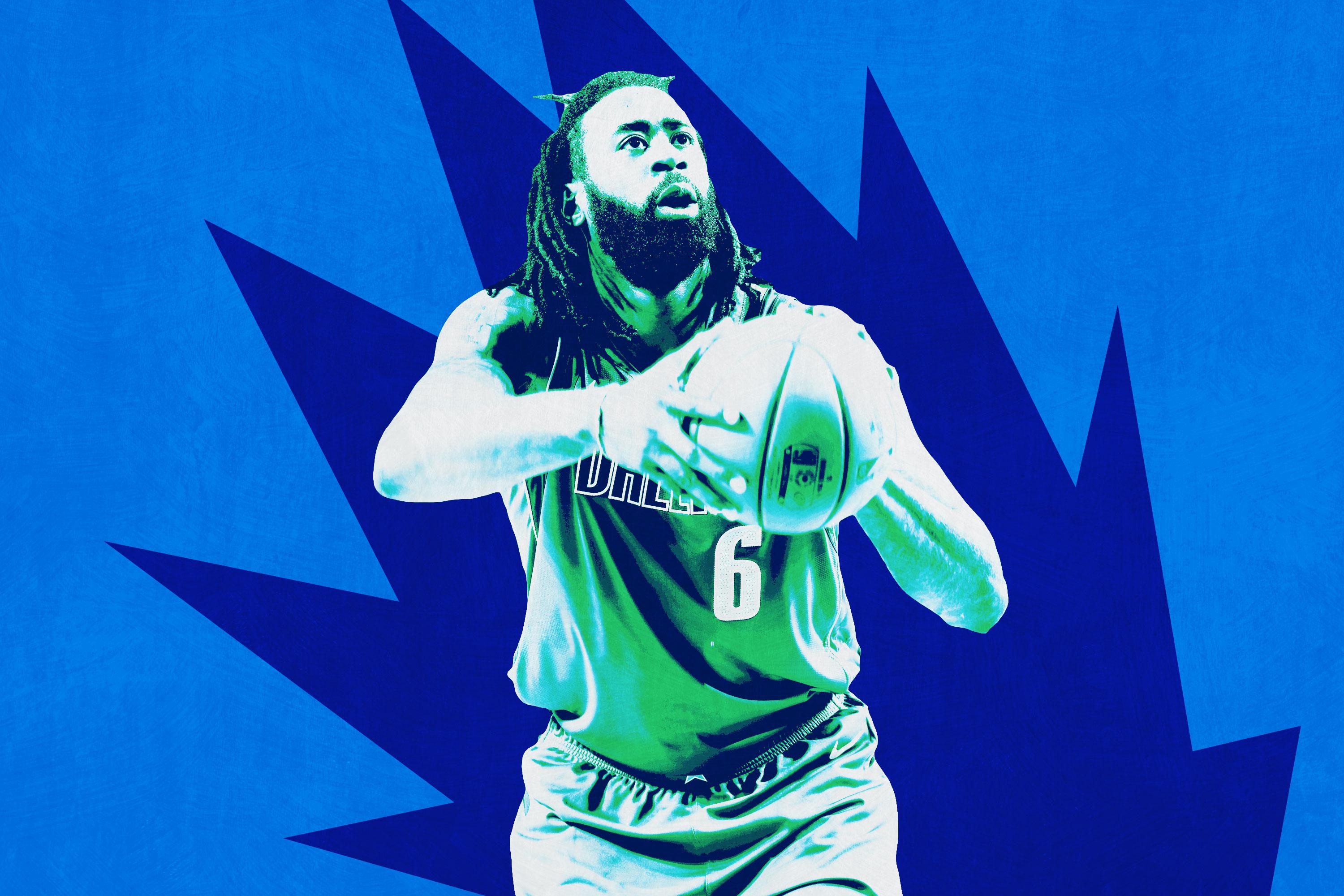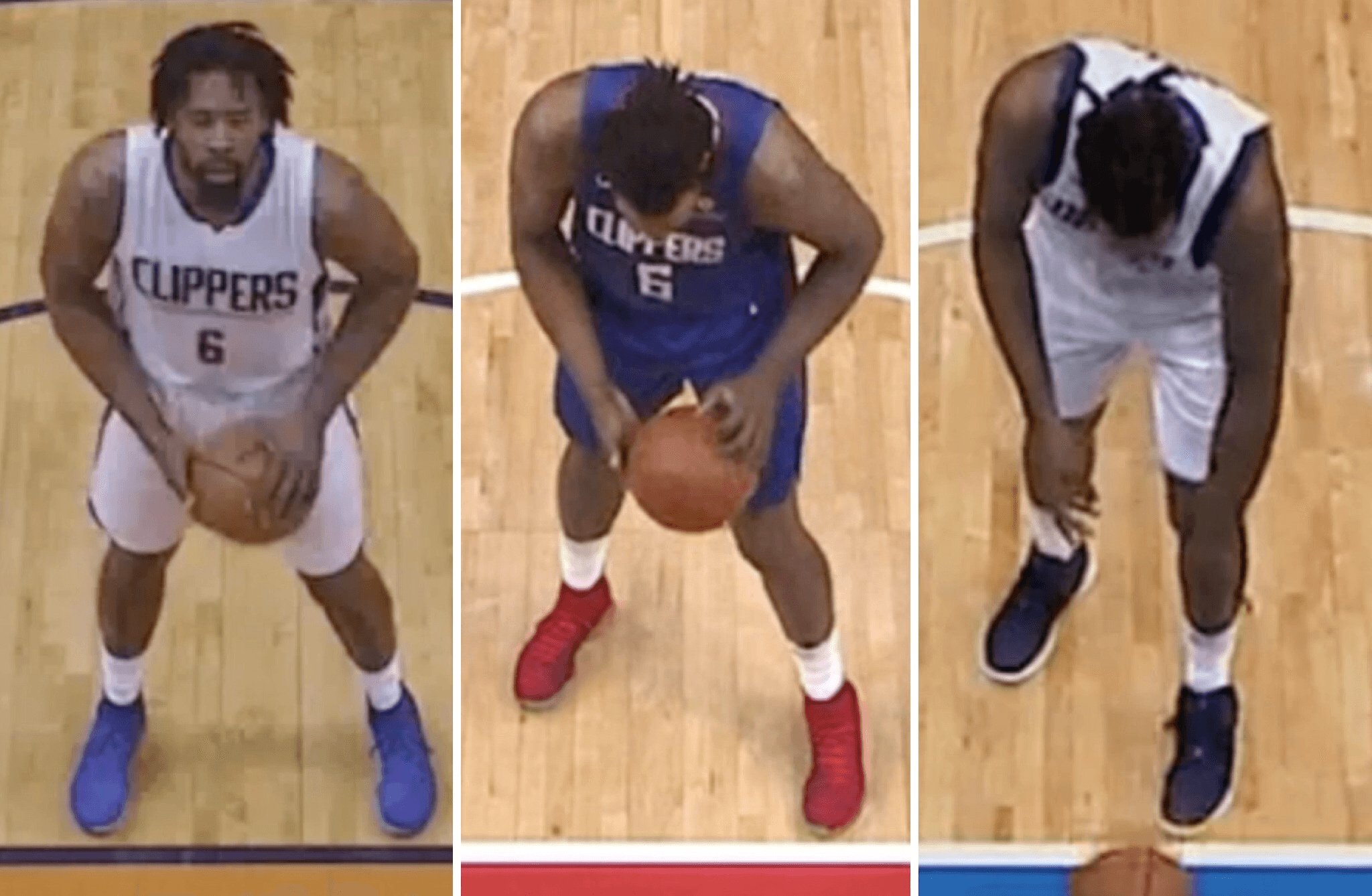
DeAndre Jordan is in the zone. After years of being hacked by opponents to force the 45.5 percent career free throw shooter to the line, Jordan is shooting a career-best 75.8 percent on free throws during his first season with the Dallas Mavericks. In his warm-up before a game against the Lakers last week in Los Angeles, Mavs assistant coach Jamahl Mosley shouted “Free throw zone!” when it was time for Jordan to begin a rapid-fire shooting drill.
For about 30 seconds toward the end of Jordan’s workout, Mosley and court attendants operated like an assembly line for Jordan, who launched free throws without dribbling. It looked like a juggling act with multiple basketballs in constant motion. “The results are there,” head coach Rick Carlisle said last week in Los Angeles before the Mavs lost to the Lakers. “He knows the work never stops. That’s why you see him out there before games going through his routine and process, and all the things he needs to do to keep it going and keep improving.”
When Jordan was asked in late October about what he’s doing differently from the line, he deadpanned, “Nothing.” Jordan declined an interview to discuss his newfound free throw shooting prowess, but he’s made numerous prominent changes to his form and to his routine.
Jordan has made a big shift in how he sets his feet when he steps to the line. The 6-foot-11 center previously had both feet positioned up against the line, with both feet pointed toward the rim and his legs spread apart in a wide stance. Last season, when he improved to 58 percent from the line (his previous career high), he moved his right foot back slightly and retained his wide stance; he briefly experimented with a similar alignment during the 2012-13 season, when he constantly tweaked his mechanics and shot only 38.6 percent. It didn’t work then, and it didn’t work well enough last season. He made a more drastic change this offseason. He’s kept his right foot behind his left foot, but now the distance between his feet is narrower than it’s ever been.

When I asked Carlisle why this adjustment was made, he quipped, “I really am not interested in getting into a whole thing about technique and strategy.” It’s not the first time Dallas has made such an adjustment. Shortly after acquiring Rajon Rondo in 2014, the Mavericks made an identical change to Rondo’s stance. Rondo, a 60.4 percent career free throw shooter, didn’t stick with the tweaked alignment at the line, but it did help his jumper. Coaches have told me that players with long arms, like Jordan and Rondo, can feel shoulder tension if they point both feet at the rim; it’s harder to tuck the elbow in to keep it aligned with the rim. By shifting a foot back, a shooter can more naturally align their hand and shoulder with their hip and feet to create a more comfortable, looser release. Jordan’s shot has never looked more relaxed than it has this season.
When Jordan entered the NBA in 2008, he used to bring the ball toward the side of his head, then shoot. It looked like—and operated as inaccurately as—a medieval catapult.
Video from the 2012-13 season
Midway through the 2012-13 season, Jordan started bringing the ball in front of his face and releasing at a higher point, a method he’s kept basically ever since. But the way that he brings the ball up to the release has varied over the years.
Last season, Jordan brought the ball up, lowered it to about the level of his chest, paused, then shifted it back up into his shot. It looked like he was drawing a squiggly line with the ball. Now, he starts low with the ball positioned just above his knee and goes straight up into his shot; he’s drawing a straight line. Here’s a side-by-side comparison of last season versus this season.
2017-18 season (left), 2018-19 season (right)
By starting with the ball low, Jordan incorporates a springlike motion into his shooting release. And by moving the ball straight up, there’s less unnecessary movement, making it easier to replicate.
In February 2016, with his free throw shooting still stuck in the 40 percent range, Jordan admitted to then Clippers teammate JJ Redick that his struggles were “more mental than anything.” “You can get reps up in the gym as much as you want, hours and hours,” Jordan said on The Vertical Podcast With JJ Redick, “but when it comes to a game, there’s so many different aspects going on, so many different things. In the game, it’s so different. The pressure is on. I’m just gonna keep shooting them, and it’ll come.” Nearly three years later, it’s finally starting to come for Jordan—thanks to some changes to not just to his foot placement, but his entire free throw routine.
Video from the 2018-19 season
Immediately after Jordan is fouled, he seeks out the ball. He’ll chase it down, or touch it while the referee is holding it. Opponents aren’t accommodating; sometimes Jordan will need to wrestle for it, like he does with Mike Scott in the clip above. It’s unclear why Jordan started doing this, but it is a change from what he’s done in the past: Today, he moves toward the ball; in the past, he moved away from it.
Video from the 2017-18 season
After touching the ball and getting to the line, he’s also started talking. Jordan pauses and asks a teammate a question after the referee bounces the ball to him. Last month, when asked what Jordan was saying before he shoots, Carlisle smirked and declined to share. “I didn’t know he was saying anything,” Carlisle told reporters. “Whatever it is, he should keep doing it.”
Before the Mavs faced the Lakers, I asked Jordan’s teammate Harrison Barnes about this routine, and he started laughing. “He’s a talker. He’s always asking questions,” Barnes said. “He’s asking, ‘Who you guarding?’”
Video from the 2018-19 season
Every time, a Mavericks player answers the question verbally or by pointing at an opposing player. Jordan has never done anything like this before. Throughout his entire career, he’d remain quiet at the line; usually he’d keep his eyes locked on the rim, even while dribbling before shooting. Jordan has taken a completely different approach this season.
I wondered whether the team had ever discussed that Jordan talks so much at the line before shooting. Barnes said no. “He just started calling guys out. Now we’ll be standing there wondering who he’ll call out first,” Barnes said.
Jordan wouldn’t be the first struggling shooter to use a vocal cue to get in a focused mind-set. Karl Malone shot 48.1 percent from the line as a rookie in 1985-86, 59.8 percent in 1986-87, and 75.7 percent for the remainder of his Hall of Fame career. Early in his career, Malone connected with Keith Henschen, the Utah Jazz’s sports psychologist consultant at the time, and learned that a trigger word could keep him calm and confident at the line. Malone would mumble to himself before shooting; years later, Henschen revealed that Malone said, “This is for Kay and the baby.”
After Mark Cuban bought the Mavericks in 2000, he hired Don Kalkstein as director of sports psychology, making the Mavs the first franchise in the NBA with a full-time team psychologist. Kalkstein has been with the team ever since—aside from a stint from 2005 to 2008, when then Mavs head coach Avery Johnson didn’t want him around the team. Kalkstein got rehired once Carlisle replaced Johnson; and in 2012, a year after the Mavs won the title, Cuban said that letting Kalkstein go was his biggest regret. “I think if I hadn’t done that, we win a championship with Avery,” Cuban said on ESPN Dallas 103.3 FM’s Ben & Skin Show. “Organizations may not win championships, but organizations can lose championships. I think there’s just so many little things that people don’t realize are important.”
Jordan told Redick in 2016 that he’d get “frustrated and nervous” when he shot free throws. “I used to think, ‘Don’t fucking air ball. Anything but an air ball. I don’t want to be on Shaqtin’ a Fool,’” Jordan said. Kalkstein discussed solving this self-defeating mind-set with the L.A. Times in 2015. “[Players] do so much training—physically, fundamentally—that they often lack mental skills training,” Kalkstein said. “We don’t want the thought process to be ‘I have to make this shot.’ We want the thought process to be, ‘I’m going to catch and shoot, I’m going to get myself in a good position.’ So they concentrate and focus more on the process, which eliminates what we consider pressure and anxiety.”
We’ll see whether Jordan can sustain his success from the line, but for now, he’s well beyond the threshold for intentional fouls. The Mavericks can keep Jordan on the floor at the end of games, which gives his game more value as he ages into his 30s and hits unrestricted free agency next summer.
“I’m real happy for him. This is a big thing being able to work at conquering something like that,” Carlisle said last month. “We talked to him about a couple things that we thought could help, and then he put in the work.” It’s taken 11 seasons, but Jordan may have finally found his zone.